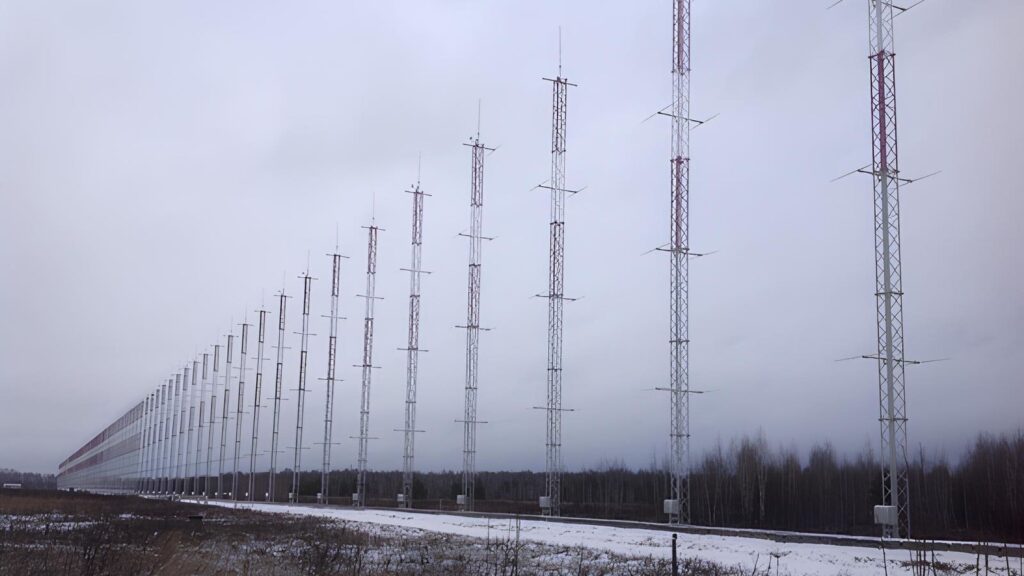container radar.
Wikimedia Commons
The second target of Ukraine's explosive-laden robotic sports plane is an over-the-horizon radar with a range of 1,900 miles located in the Russian town of Kovilkino, 370 miles from the Ukrainian front line.
Last week, the Ukrainian military reportedly launched a long-range drone sortie to attack a large container OTH radar, but it was unsuccessful. So they tried again today and were able to gain access to a vast radar facility with 145 masts, each at least 100 feet tall.
video Photographs taken from the ground, apparently by Russian civilians, show a modified Aeroprakt A-22 sports plane flying towards the container facility, followed by smoke billowing from the apparent explosion site. .
The fact that the Ukrainians had to fly multiple drones into the container shows how difficult it is to attack a radar that is hundreds of miles from Ukrainian fronts and whose components are spread out over acres. It highlights how difficult it is. Don't expect containers to go down easily. do It is expected that the Ukrainians will continue to attack their own radar.
The $110 million container is Russia's only over-the-horizon radar aimed westward to monitor European airspace. Other OTH radars point north from Russia's Arctic Circle.
OTH radar follows the curvature of the Earth and reflects the signal off the ionosphere. During the Cold War, the world's nuclear powers deployed OTH radars for early warning of nuclear attack. Today, OTH radar also allows wealthier countries to detect and track enemy aircraft, missiles, and drones from great distances.
OTH radars are not necessarily as accurate as conventional radars, but conventional radars must operate within a few hundred miles of the front line. This makes them vulnerable to all kinds of enemy attacks.
In contrast, OTH radars should be immune to all but the longest range attack weapons, which most countries do not possess. For much of Russia's 26-month war with Ukraine, Russian air defense commanders could rest assured that their farthest radars were far beyond the range of Ukrainian forces. .
But Kiev, with foreign support, has allocated top engineers and large sums of money to develop an entirely new class of long-range attack drones. And since the beginning of this year, these drones have extended their range to 600 miles inside Russia, hitting air bases, command centers, oil depots, strategic industries, and now container radars.
One of the longest of these long-range attacks took place on April 2nd, when the Ukrainian military flew at least one autonomous A-22 into Russia's Arabga Special Economic Zone industrial campus, 600 miles from the Ukrainian border. and attacked part of the facility. The company manufactures the Iranian-designed Shahed drone for the Kremlin.
This self-flying sports aircraft is one of the best among the 15 or so long-range drones available in Ukraine. It is large enough to carry hundreds of pounds of explosives and can also carry enough fuel for long-distance flights. What's more, the aircraft costs just $90,000.
At the production level, the A-22 drone is scalable. As such, after analyzing the Arabga attack, which reportedly injured 14 people and damaged a drone factory or nearby worker dormitories, Ukraine's Conflict Intelligence Team said: “We anticipate further attack attempts in the future.'' “There is,” he said.
That's exactly what happened two weeks later, when at least one A-22 buzzed into container radar with an explosive payload.
It is too early to tell whether and how badly today's drone attack caused damage to containers. Killing one or more receiver towers does not permanently disable the radar. If the Ukrainians were smart, skilled and lucky in the planning and execution of the raid, they could have targeted the radar control center, but without it the tower would be useless.
After two attacks in the space of a week, it's safe to say that the Ukrainians are determined to suppress, if not destroy, the containers. This is apparently a far-reaching move that will make Ukrainian airspace safer for Ukrainian military aircraft, including ex-European F-16s scheduled to arrive in the coming weeks, while simultaneously blinding Russian air defenses from drone attacks. This is part of our strategy.
The most dramatic moment in its anti-radar strategy occurred earlier this year, when a long-range Ukrainian surface-to-air missile shot down two rare Russian Air Force Beriev A-50 radar planes. To conclude that phase, Ukrainian drones targeted a factory in southern Ukraine where Beriev is repairing damaged A-50s and manufacturing new ones.
With Russia having disposed of much of its prewar inventory of about nine A-50s, Ukrainians turned their attention to Russian weapons and increasingly sophisticated drones. Ground-Based radar.
source:
1. ukrainian pravda: https://www.pravda.com.ua/eng/news/2024/04/17/7451634/index.amp
2. TASS: https://tass.com/defense/1132191
3. Dispatch Information Team: https://notes.citeam.org/dispatch-apr-1-3-2024
4. @PStyleOne1: https://twitter.com/PStyle0ne1/status/1780644665936445911


